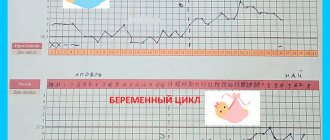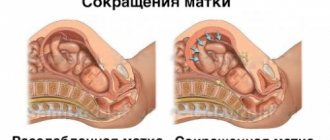Pregnancy does not always proceed without any disturbances in the health of the expectant mother. And if, subject to a healthy lifestyle, serious complications can be avoided, then no one is immune from high temperature.
Fever is not a separate disease, but one of the symptoms of an illness. If the temperature rises during pregnancy in the third trimester, it means that the woman’s body has reacted in a similar way to the development of the disease.
The most common causes of fever in the final three months of pregnancy are:
- Infection of a pregnant woman with ARVI or influenza.
- Inflammatory process in the female body, for example, with diseases of the kidneys, gall bladder, etc.
- Food poisoning accompanied by intoxication.
- Overheat. Thus, in the summer months, the temperature may rise due to prolonged exposure to the street. The cause may also be stuffiness in the room, transport, etc.
- The time of birth is approaching. An increase in temperature to 37 or even 37.2 degrees is quite normal just before the baby is born. Not all women’s bodies react in this way to the approach of labor, but it has been noted that anxious and suspicious women are more prone to such a manifestation. This is a kind of reaction to stress and fear of the birth process.
The exact cause of changes in well-being and increase in temperature can be reliably found out only by visiting a doctor and, if necessary, undergoing the required examinations.
Temperature during pregnancy: third trimester
During pregnancy, the 3rd trimester is an important time when all the resources of the mother’s body are aimed at preparing for childbirth. At this moment, the immunity of pregnant women is tense, a large number of cytokines and antibodies are released into the blood, which should overcome possible infections. These substances interact with the thermoregulation center in the hypothalamus.
Therefore, in the 3rd trimester of pregnancy, a slight physiological increase in the numbers on the thermometer is possible. It should not bother the woman and the doctor. A temperature during pregnancy in the third trimester of 37 degrees is absolutely normal.
You should not knock down low-grade numbers with folk remedies and medications. This can only harm the body of mother and baby. However, it is worth monitoring the thermometer readings, because over time they can seriously change and become pathological.
If in the third trimester the temperature is 37 degrees, but there are additional symptoms of the disease, then it is already considered dangerous. In addition, with high thermometer values (38 degrees and above), serious pathology is likely to be present.
Nutrition in the third trimester of pregnancy
Nutrition in late pregnancy is of great importance for the normal well-being and full development of the child. Now the baby is almost formed and is actively gaining weight, the mother’s task is to “provide” him with the nutrients and beneficial substances necessary for this. Thus, nutrition in the third trimester of pregnancy must include a daily intake of protein, the source of which is boiled lean meat and fish. But a pregnant woman should be careful with fish: some types of fish contain quite a large amount of mercury, which is harmful to the baby. The optimal “option” for a woman is cod, salmon, tuna, but it is better to avoid king mackerel. Again, eggs, dairy and fermented milk products will provide your baby with protein and additional calcium.
It is advisable to enrich your diet with fresh vegetables and fruits - a sufficient amount of fiber will prevent constipation, and vitamins and minerals will maintain vitality and the body in good shape. Useful foods for pregnant women at any stage, including in the third trimester of pregnancy, are beef, beef liver, pomegranate and tomato juice, which maintain hemoglobin levels and prevent the development of anemia.
It is better to avoid flour products, confectionery products, sweets, and sweet soda for a while - they can provoke additional weight gain, which is undesirable during pregnancy. In addition, you should exclude fatty and spicy foods from your diet: in addition to the fact that such food can cause heartburn, it also retains fluid in the body and the development of edema. To avoid such a situation, you should limit your salt intake, and also carefully maintain a water-drinking balance: the amount of liquid consumed per day should not exceed 1.5 liters, including juices, soups, milk, and fruits.
It is better to take food in fractions, often and in small portions, eating when there is a need for it. Food should be healthy and natural; it is better to avoid fast food and all kinds of semi-finished products. In general, your daily calorie intake should be about 3,000 kcal.
Reasons for the increase
Temperature during pregnancy in the 3rd trimester can increase under various pathological conditions. At this time they pose quite a great danger to the baby and the period of childbirth. Therefore, it is important to know the main causes of the symptom:
- Acute respiratory viral diseases.
- Pneumonia and ENT pathology.
- Obstetric and gynecological diseases.
- Pyelonephritis in a pregnant woman.
There are other possible reasons for the rise in temperature, because any chronic disease can worsen during pregnancy. However, statistically, these are the diseases that most often cause fever.
Even a temperature of 37 during pregnancy, combined with the symptoms of the listed conditions, can cause serious consequences. Therefore, it is important to exclude these diseases or treat them in a timely manner.
ARVI
Both during pregnancy and outside of this state, the most common cause of fever in a person is a common respiratory viral infection. The causative agents of this disease are numerous and surround us everywhere, so it is quite easy to get ARVI.
In the third trimester, a woman’s immune system tries its best to protect the body, but sometimes it fails.
Manifestations of the disease are known to everyone:
- Abundant catarrh in the nasal cavity.
- Cough and sore throat.
- Temperature rises to low levels.
- Weakness and headache.
- Nasal discharge and sputum when coughing are mucous in nature.
It is necessary to treat such ARVI, but use only symptomatic remedies. A pregnant woman should take a break from any work, stay in a ventilated but warm room, and drink plenty of fluids. The body itself will cope with the infection if you create a protective regime for it.
It is necessary to distinguish ARVI from influenza. This infection is much more dangerous and can harm the baby. Symptoms of influenza are characterized by a pronounced temperature reaction at the beginning of the disease and scanty catarrhal symptoms. Influenza is characterized by muscle and joint pain. For severe flu, doctors prescribe antiviral drugs, which can be used in pregnant women with a high risk of complications from the disease.
ENT pathology and pneumonia
Acute respiratory viral infections do not carry a serious risk for pregnancy outcome on their own. However, they are dangerous because they reduce immunity and damage the mucous membrane of the respiratory organs. Under these conditions, acute purulent pharyngitis, laryngitis and sinusitis often occur. Chronic variants of these diseases are also worsening.
Symptoms of ENT pathology:
- Sore throat, redness, possible formation of an opaque plaque.
- White or greenish discharge.
- The second wave of fever is a repeated increase in temperature after it has decreased.
- With tonsillitis in acute and chronic forms, the tonsils become enlarged and painful.
- With sinusitis and rhinitis, nasal breathing is disrupted and purulent exudate is released abundantly.
The bacteria that cause these diseases rarely penetrate the placental barrier. However, they deplete the expectant mother’s body and cause a severe inflammatory response. Under these conditions, the baby's maturation is disrupted.
Another serious respiratory infection is pneumonia. Doctors call this condition pneumonia. It can occur after a previous acute respiratory viral infection or without it. Manifestations of the disease are fever and cough with purulent sputum. Pneumonia is a serious disease and requires the prescription of antibiotics, not all of which can be used during pregnancy.
Obstetric complications
The most dangerous reason for the successful completion of pregnancy is obstetric diseases. These include:
- Chorioamnionitis.
- Vulvovaginitis.
- Cervicitis.
- Endometritis.
- Trichomoniasis.
The most common of these diseases in the third trimester is chorioamnionitis.
Manifestations of obstetric pathology are:
- Marked increase in temperature.
- Weakness and headache.
- Purulent discharge from the genital tract.
- Swelling and hyperemia of the vaginal walls.
- Pain in the lower abdomen.
- Cramping phenomena.
- Increased leukocytes in the general blood test.
- High breathing and heart rate.
Obstetric pathology often requires immediate cesarean section. Sometimes the pathology is treated conservatively with antibiotics, if there is no serious risk of infection of the fetus.
Pyelonephritis
During pregnancy, infection in the renal pelvis often worsens. Doctors even identify a condition such as gestational pyelonephritis. This disease can cause fever at the end of pregnancy.
The growing uterus causes partial obstruction of the urinary tract. Compression of the bladder allows urine to flow retrogradely into the renal calyces, leading to infection.
Manifestations of the disease:
- Fever of varying severity.
- Pain in the lower back, often unilateral, of a pulling nature.
- Weakness, decreased performance, nausea and vomiting.
- Detection of bacteria and leukocytes in a general urine test.
- Leukocytosis in a blood test.
Pyelonephritis not only causes intoxication of the body, but can also cause sepsis. This complication is characterized by the spread of infection to various foci in the body, which can be fatal for the pregnant woman.
Therefore, obstetricians and gynecologists take urinary infections very seriously. Antibiotics and uroseptics are used for treatment. Detoxification of the body of the expectant mother is very important.
If you notice signs of this disease, immediately contact a specialist for detailed treatment recommendations.
Vitamins in the third trimester of pregnancy
Vitamins in the third trimester of pregnancy are still “relevant” and necessary, both for the mother and for the baby, who is growing by leaps and bounds. Of course, the optimal option is considered to be one in which the expectant mother receives all vitamins and microelements from food - and therefore, such attention is also given to the issue of a balanced diet. But it happens that a woman may be advised to take additional vitamins; in this case, the choice of the most suitable multivitamin complex should be discussed with a doctor. So, what vitamins must be supplied to the body of the expectant mother in the third trimester of pregnancy?
Vitamin A – necessary for the growth and development of the baby’s skin, bones, mucous membrane of the eyes, for the normal functioning of the mother’s liver and immune system, as well as for the prevention of anemia (promotes the absorption of iron);
B vitamins – participates in the creation of the baby’s blood cells and prevents the occurrence of seizures in the mother;
Vitamin C - strengthens the walls of blood vessels, supports the immune system, however, exceeding the dose is not recommended, as this may lead to the development and/or worsening of gestosis;
Vitamin E – prepares the baby’s lungs for independent breathing, reduces the threat of premature birth;
Vitamin K - takes part in the regulation of blood clotting, prevents possible bleeding;
Vitamin D – together with calcium, maintains the normal state of bone tissue and is required for the development of a child’s bones and teeth.
Consequences
Why should fever be controlled at the end of pregnancy? Fever and its causes can cause a number of dangerous complications:
- Premature birth. At the beginning of the 3rd trimester, the fetus is not yet fully developed. Sudden birth can harm a baby who is not yet ready to be born. Tocolytic therapy can prevent labor, but this does not always happen.
- Fetoplacental insufficiency. Fever contributes to intoxication of the body; this condition disrupts the transport of oxygen and nutrients from mother to baby. FPN is especially often observed in specific obstetric infections.
- Preeclampsia and eclampsia. These conditions are dangerous not only for carrying a baby, but also for the health of the pregnant woman. Against the background of high temperature, the development of convulsions, oxygen starvation of the brain and death are possible.
- Infection of the placenta and fetal membranes. This complication is not caused by the elevated temperature itself, but by its causes. Bacterial infections are dangerous for the development of sepsis. Bacteria penetrate the amniotic organs and infect the baby's body.
- Immaturity of the cervix. In conditions of active fight against infection, the reproductive system stops preparing for childbirth. Sometimes, due to the immaturity of the reproductive tract, a woman has to undergo surgical delivery.
- Postpartum infections in mother and fetus. On the woman's side, endometritis is often encountered, and inflamed sutures come apart. The baby's eyes and respiratory organs become infected, and in some cases, neonatal sepsis occurs.
This list of consequences of fever in the third trimester goes on and on. You need to fight not only the symptom, but also its causes.
Ultrasound in the third trimester of pregnancy
Ultrasound in the third trimester of pregnancy is a mandatory routine examination, usually performed at 32-34 weeks. The task of the last, actually “prenatal” ultrasound examination is to assess the development of the baby’s organs and systems, as well as to determine the readiness of the mother’s body for the upcoming birth. So, during an ultrasound in the third trimester of pregnancy, the doctor assesses the size of the fetus and confirms the date of birth, determines the correspondence of fetal development to the scheduled date of delivery.
The presentation of the fetus is determined during an ultrasound examination, which makes it possible to determine the tactics of labor management (breech or pelvic presentation may become an indication for cesarean section). The purpose of ultrasound in the third trimester of pregnancy is also to determine the degree of maturity of the placenta and its location, assessing the uteroplacental and fetoplacental blood flow.
As in earlier stages, in the third trimester of pregnancy, ultrasound can detect congenital malformations of the fetus. Although gross pathologies can be determined during the first and second planned ultrasound, some diseases of the baby, for example, renal hydronephrosis (fluid in the kidneys), appear only towards the end of pregnancy. Having identified this or that pathology, the doctor will be able to decide on further tactics: a premature delivery may be necessary or a decision will be made on surgical intervention immediately after the birth of the child.
Non-drug treatment
From the above, we can conclude that not every temperature during gestation should be reduced. So, in the third trimester we knock down the thermometer numbers if:
- The thermometer readings exceed 37.5 degrees.
- The temperature rose rapidly in a short time.
- Fever is accompanied by symptoms of the listed diseases.
- Sometimes it is necessary to reduce low-grade fever if recommended by the doctor.
How to reduce fever during pregnancy? It is worth starting antipyretic therapy with the help of folk remedies:
- Drink plenty of alkaline drinks. Compotes and fruit drinks at room temperature help relieve intoxication in the body.
- Sweet black tea with lemon and honey or raspberries helps reduce fever.
- Tea made from plantain, coltsfoot and raspberry.
- A weak or diluted decoction of chamomile and linden.
- Cold compresses on the forehead and wiping with a wet towel.
The listed products in moderate quantities are safe for the fetus and the pregnant woman.
How and with what to reduce the temperature of a pregnant woman with a cold?
A woman, in anticipation of a joyful event - the birth of a baby, must take special care of her health during this period, because her body is subjected to double stress and spends energy and resources on the normal development and growth of the child.
But it is at this time that there is an increased risk for the expectant mother to catch a cold, accompanied by high fever, runny nose and cough.
How, and most importantly, what is the right way to lower a fever so as not to harm not only your health, but also the health of the baby?
Causes of high temperature in pregnant women
It is normal for a woman to have a fever during pregnancy.
In pregnant women, an elevated temperature is not always a sign that the woman has a cold.
Indeed, depending on the trimester of pregnancy, body temperature may be elevated by several degrees and this is considered normal.
First trimester
During the first trimester of pregnancy, taking antipyretics is prohibited.
During the first three months after conception, the body temperature of many women rises slightly, sometimes even up to 37.5 degrees. This is due to the fact that the body produces more of the hormone progesterone , which is responsible for the normal development of pregnancy.
If no other symptoms of a viral disease are observed, then the expectant mother has nothing to worry about. Moreover, taking antipyretics is strictly prohibited, because elevated temperature is not associated with a cold and is normal in the first trimester of pregnancy.
Second trimester
In the second trimester of pregnancy, a body temperature of 37 - 37.5 is considered normal.
If during the first trimester the pregnant woman’s body reacts to the changes occurring in it and the increased level of progesterone with a slight increase in temperature, then in the second trimester everything returns to normal and the body adapts to the new state.
But, despite this, expectant mothers rarely have a normal temperature during this period with an indicator of 36.6. As a rule, it remains slightly elevated and the thermometer reading can reach 37 or 37.5 .
As noted above, such a temperature is considered normal for pregnant women and, if it is not accompanied by unpleasant symptoms such as a headache or runny nose, the woman has nothing to worry about.
Third trimester
In the third trimester of pregnancy, if your temperature rises, you should consult a doctor.
In the last three months of pregnancy, the normal body temperature of the expectant mother should vary between 36.6–37 degrees . If this indicator is higher, then this is a serious reason to consult a general practitioner.
Why is high temperature dangerous during the third trimester? It can cause premature birth or complications during childbirth , so it is necessary to find out the cause of its occurrence as soon as possible and begin to fight it.
In any case, if a woman is expecting the birth of a child, she should consult with her doctor to make sure that the elevated temperature is not associated with a virus entering the body or inflammatory diseases.
Medicines to reduce fever for colds
If an expectant mother has caught a cold accompanied by a high fever, then the question that is especially relevant for her is what safe medications will help reduce it. Indeed, during this period, most medications for pregnant women are contraindicated, as they can harm the baby.
Before starting treatment, you should make sure that the thermometer has not reached above 38 degrees , because everyone knows that such a temperature cannot be brought down, since in this way the body begins to fight the infection.
If a pregnant woman's temperature rises above 38 degrees, medications such as Panadol or Paracetamol can help. These drugs are considered safe for expectant mothers and effectively reduce high fever.
Paracetamol is safe for pregnant women.
Even these medications should be taken only after doctor's approval, especially in the third trimester of pregnancy.
How to reduce a pregnant woman's temperature using folk remedies
Raspberry tea is very effective at high temperatures.
are considered safer means of reducing fever . Even doctors recommend that pregnant women use them to reduce their temperature.
- Raspberry tea is very effective at high temperatures . It can be prepared with raspberry jam or frozen raspberries, adding a spoonful of natural honey.
- Linden blossom tea also helps combat this problem well .
- Milk with the addition of a teaspoon of honey and butter will help bring down the temperature All ingredients are mixed and heated slightly so that the oil and honey dissolve.
- Cranberry tea or compote made from these berries also effectively fights fever.
- You can brew tea from rose hips . They are safe and even healthy, because they are a storehouse of vitamin C.
- Cool compresses are also used for this purpose , which are placed on the forehead of the pregnant woman.
- Another good method is cabbage leaf compress . The sheet is scalded with boiling water, smeared with honey and placed on the chest area. Attention - the cabbage should not be hot, only warm.
Despite the fact that folk remedies do not harm the expectant mother and her baby, they should not be abused, especially in the last three months of pregnancy.
If, despite all efforts, the temperature continues to rise inexorably, it is necessary to call an ambulance, because this may be a signal of a serious illness.
How not to lower the temperature
First of all, expectant mothers should remember that they absolutely cannot lower their temperature with drugs such as Analgin, Aspirin, Efferalgan or Fervex. They can not only harm the health of the pregnant woman, but also cause miscarriage or bleeding.
The drug Analgin should absolutely not bring down the temperature.
Another popular method is wiping the expectant mother’s body with a compress soaked in vodka or alcohol, which is also undesirable. The fact is that harmful substances from them can penetrate through the skin into the blood and harm the baby.
You should not wrap a pregnant woman with a high temperature with a warm blanket or blanket. Overheating of the body negatively affects the condition of the patient and her unborn baby.
conclusions
You should not believe advertisements praising safe means for reducing fever, which can be taken even by pregnant women and small children, and run to the pharmacy for medicine. Only a doctor can prescribe appropriate treatment.
And finally: any disease is easier and easier to prevent than to treat later. This is especially true for expectant mothers, because they are responsible for a small life. Strengthening the immune system, walking in the fresh air and taking more vitamins will help a woman carrying a baby stay healthy and active for nine months.
A walk in the fresh air will give expectant mothers health and immunity.
Source: https://ayamama.ru/chem-sbit-temperaturu-u-beremennoj-zhenshhiny-pri-prostude-kak-luchshe/
Drug therapy
How to bring down the temperature if folk remedies do not help? There are quite a large number of antipyretic drugs, but not all of them can be used in pregnant women:
- Aspirin should not be taken during pregnancy for its antipyretic effect. The dose required to reduce the temperature can harm the baby. Aspirin causes bleeding and fetal malformations.
- Paracetamol-based medications can be used during pregnancy. You should always use the medicine at half the dose first, perhaps this will be enough to reduce the thermometer numbers.
- Indomethacin and other NSAIDs can be used, but only as a last resort. They reduce fever worse than paracetamol, and there are many more side effects from medications for pregnant women.
After taking the medicine, you should call a doctor or consult a gynecologist yourself. It is important to find the cause of the disease and treat it with antiviral or antibacterial drugs.
Causes of elevated temperature
First of all, if you have a fever, you need to find out the reason. This is often associated with infections such as influenza and ARVI. An exacerbation of any chronic diseases cannot be ruled out.
If you are in the third trimester and your body temperature exceeds 38.0°C, then you need to take action. If, in addition to fever, you feel severe malaise, nausea, muscle pain or any other symptoms, you should immediately consult a doctor.
By the way, some women may experience an increase in temperature to approximately 37.5°C a few days before the birth of a child, but this is not a common occurrence.
What should be the normal temperature in the 2nd trimester of pregnancy?
Body temperature directly depends on the state of a person’s health, as well as on his immune system. Particular attention to such an indicator as body temperature should be paid to women during pregnancy, because in this position it is very important to monitor your health and the proper course of pregnancy. For this purpose, doctors recommend that pregnant women regularly measure their body temperature throughout pregnancy in order to promptly identify any health problems and effectively eliminate them.
Measuring temperature during pregnancy ↑
Doctors use body temperature measurements as one of the tests to determine the overall health of the mother and baby in the womb. During the first and second trimester of pregnancy, the most informative is measuring basal temperature. The level of basal temperature indicates the functioning of the ovaries and the entire reproductive system of a woman. Basal temperature measurements should be taken in the morning, before you even get out of bed. Only in this case will information about basal temperature be reliable. Starting from the 25th week of pregnancy, there is no need to measure basal temperature - it will correspond to the general body temperature, so measure the temperature in the armpit. Temperature should be measured throughout pregnancy. It is advisable to do this regularly, at least once a week, if you feel very well and nothing bothers you.
What temperature is normal in the second trimester of pregnancy ↑
when vomiting during pregnancy is normal The time when a woman carries a baby under her heart is one of the most beautiful in her life. However, quite often this period can be overshadowed by various factors. Every second representative of the fair sex,
The second trimester of pregnancy can be called the “golden” period. In this trimester, toxicosis and headaches usually pass, and the swelling and heaviness throughout the body that occurs in the third trimester have not yet begun. General health in the second trimester
Source
Ovulation and conception of a child, how pregnancy and childbirth proceed. How to determine the sex of a child, nutrition during pregnancy, yoga and exercises for pregnant women
Every mother wants to surround her newborn with boundless care and only the best things. Get everything necessary for your baby... Read more>>
The very definition of “cyst” does not sound particularly threatening. After all, this is just a formation in the form of a cavity with thin walls, filled... Read more>>
People are used to thinking that joint problems are a consequence of old age or a consequence of illness. Therefore, joint pain during pregnancy... Read more>>
Changes in the second trimester
A temperature of 37 during pregnancy in the 2nd trimester is also not a violation. However, this symptom may also indicate the development of the disease, so it cannot be ignored. A temperature of 37 at 14 weeks of pregnancy (the beginning of the second trimester) can occur as a result of the development of colds and other viral diseases. An increase in temperature values can be caused by pathologies of an infectious nature (rotovirus infection, influenza, toxoplasmosis), inflammatory diseases of the urinary tract (pyelonephritis, cystitis) and respiratory tract (bronchitis, pneumonia).
A temperature of 37 at 16-20 weeks of pregnancy is a reason to visit a doctor. If a specialist confirms the presence of pathology, treatment will be required. In the absence of the necessary therapy, a temperature of 37 during pregnancy in the second trimester can provoke placental abruption or the development of fetoplacental insufficiency.
If infectious pathologies occur, intrauterine infection of the fetus is possible.
Preventive measures to prevent fever in the third trimester
So, let's look at preventive measures to prevent fever.
During the cold season, in Russia this is traditionally the autumn-winter period, which also includes the beginning of spring, it is necessary to eat as many fruits and vegetables as possible (of course, excluding overeating), which contain vitamins especially necessary for a woman (vitamins A, E, group B, etc. ), macro- and microelements (calcium, potassium, iron, etc.), and other beneficial substances.
You should not ignore traditional remedies such as onions and garlic, unless of course you have contraindications to eating spicy foods, for example, gastritis, or individual intolerance to these vegetables. You can eat onions and garlic in small quantities, about two cloves and a small piece of onion, you can add them to the salad. All of the above remedies will help the immune system.
In the later stages, it is advisable to take foods with the maximum content of vitamin C. These include:
- kiwi;
- rose hips (you can prepare an infusion);
- black currant.
It is not recommended to consume citrus fruits in large quantities, as they are strong allergens, which will negatively affect the child’s health. However, their use in moderation is quite acceptable.
To avoid viral diseases, it is advisable for a pregnant woman in the last stages of pregnancy not to visit places with large crowds of people, for example, concerts, theaters, and various public events. The risk of contracting colds in such places increases significantly due to the rapid spread of viruses.
If you do get sick with ARVI or acute respiratory infections, then before contacting a specialist you need to rinse your throat and nose with saline solutions, which you can prepare at home yourself or purchase such products in pharmacies. You can prepare such a solution at home as follows: 1 incomplete teaspoon of salt (you can use sea salt) per 1 glass of water (200-250 ml). You can add half a teaspoon of baking soda to this solution. Such solutions can be used to rinse the nose and throat and as a prophylaxis against acute respiratory viral infections.
The pregnancy period forces the mother to treat her own condition with maximum attention and responsibility. If a temperature appears in the third trimester of pregnancy, this means that not everything is fine with the patient’s body, because thermodynamic indicators of 35.8-37°C are considered normal for this period of gestation. Their excess cannot in any way be attributed to hormonal changes, as before, so it is necessary to establish the cause of hyperthermia.
Joyful anticipation of the birth of the long-awaited heir
The baby has been growing and developing in mom’s tummy for more than 6 months. In the seventh month, the 3rd trimester of gestation begins, which ends with delivery. This stage is considered preparatory, and at the end of it, the mother will safely meet the baby.
- Over the previous months, the uterus had enlarged, the stomach had noticeably rounded and began to protrude. Because of this, mommy begins to feel clumsy, clumsy and helpless. And in later stages, mothers sometimes cannot even tie their shoelaces on their own.
- Mommy is often bothered by training muscle contractions, in this way the uterine body prepares for the upcoming work. An enlarged abdomen causes pain in the back and lumbar region.
- Often at this stage of gestation, pregnant women develop varicose vein problems and hyperedema of the limbs.
- Now the patient is recommended to rest more, elevating her legs to an elevated position, to walk more, to spend more time outside the city, in the fresh air.
- And watch your weight, the norm is a weekly weight gain not exceeding 300 g.
Toxicosis
In the final trimester of pregnancy, the mother should monitor her feelings as closely as possible and especially closely record the slightest changes in her health. If at the beginning of pregnancy the manifestations of toxicosis are considered completely natural, then by the end of pregnancy this sign indicates the development of gestosis. This condition in the later stages is considered dangerous for pregnancy, the fetus and the mother. Typically, late toxicosis is accompanied by nausea, swelling and sudden weight gain, signs of high blood pressure, etc.
Also, signs of nausea may indicate the development of liver problems or poisoning, which can occur in pregnant women when taking iron supplements. But usually nausea is not a consequence of serious problems, they can appear as a result of changes occurring in the uterine body; an enlarged organ lifts the stomach upward, putting pressure on it, which is why nausea may appear. But it’s still worth discussing this problem with your doctor. Only a specialist will be able to find out the exact causes of ailments and determine the degree of their threat to the baby and the pregnant woman.
Ultrasound
Excellent mandatory inspection record
In the last trimester, the mother will undergo a planned ultrasound examination, which is carried out at 32-34 weeks. This diagnosis is necessary to assess the degree of fetal development and the readiness of the female body for labor. Fetal parameters are assessed, the preliminary date of delivery is confirmed, and the correspondence of fetal size and PDR is compared.
The uzist also determines fetal presentation, which helps to choose the most favorable tactics for managing the delivery process. If the presentation is breech, the doctor may prescribe a cesarean section. Also during the study, the degree of placental maturity, the correctness of its location is determined, and blood flow is assessed.
Also, ultrasound diagnostics in the last trimester will help identify the presence of congenital malformations. Many pathological conditions of the fetus are detected in the first months of gestation, but there are also those that appear towards the end of pregnancy, for example, renal hydronephrosis. Having identified the presence of pathology in a timely manner, the doctor will be able to adjust further pregnancy management tactics aimed at preserving the life of the baby.
Discharge
The nature of the discharge may change or remain the same in recent weeks.
- The mucus secreted at the last stage of gestation can be liquid, thick, watery, etc.
- The main thing is that there is no unpleasant odor, no cheesy impurities, burning and itching sensations, or foaminess.
- If greenish, yellowish and unpleasant-smelling mucous discharge appears, this indicates the addition of an infectious process.
- Using laboratory tests, the doctor will determine the source of infection and prescribe adequate therapy.
Bloody discharge in pregnant women in the later weeks of gestation is considered the most dangerous. In such a situation, there is a high probability that the placenta is located incorrectly, it fits too tightly to the os of the uterus or extends into the cervical lumen. Sometimes bleeding occurs due to premature detachment of placental tissue. If your mother suddenly has bloody discharge containing clots and accompanied by severe pain, you should urgently seek help from an obstetrician-gynecologist.
Fetus
Vitamin supplements are often prescribed during pregnancy
By the third trimester, the fetus acquires a more proportional shape, its head becomes smaller in relation to the limbs and torso. Brain structures are actively developing, the depth and number of convolutions increases noticeably. The baby hears his mother’s voice perfectly, can see and feel, and the nervous system tissues are actively improving.
The production of insulin begins, which is responsible for the processes of normalizing glucose in the blood. The renal-hepatic structures complete their development. By 32 weeks, the baby reaches a height of 40-41 cm and a weight of 1700 g. The fetus begins to grow at a rapid pace, and its sucking, breathing and swallowing reflexes are well developed. The fetus lives according to its own individual schedule; at certain hours it rests or is awake. By birth, the baby reaches a weight of 2.5-4.5 kg and a height of 45-55 cm.








